Decoding Business Analyst Responsibilities
A Business Analyst plays a key role in bridging the gap between business needs and technology solutions. Their responsibilities include gathering requirements, analyzing data, and ensuring effective communication between stakeholders.
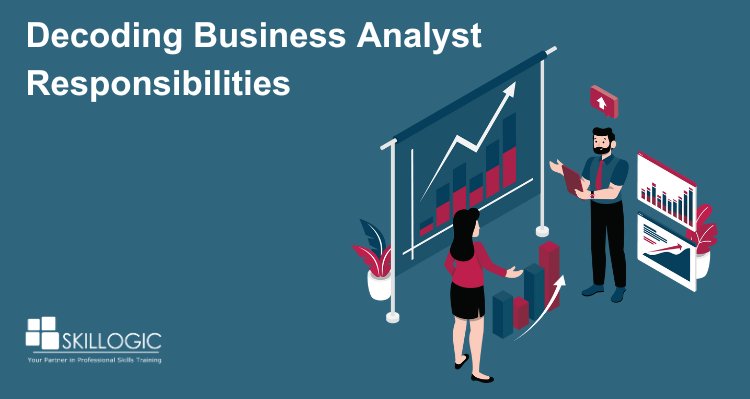
Ever wondered what exactly a Business Analyst (BA) does? In this article, we're going to break down the responsibilities of a Business Analyst in simple terms. Think of them as the bridge between technology and business goals. They play a vital role in making sure everyone understands what needs to be done and why. We'll explore the different tasks they handle, from figuring out what a business needs to communicating those needs to the right people. So, let's dive in and unravel the mysteries behind the job of a Business Analyst.
Demystifying the Business Analyst Role
Ever wondered who's behind the scenes figuring out how a business can run smoother? That's the job of a Business Analyst (BA). They're like detectives, but instead of solving crimes, they solve business puzzles. Business Analysts talk to different people in the company to understand how things are done and then come up with ways to make them better. They're kind of like the glue that holds everything together, making sure everyone knows what needs to happen to keep the business moving forward.
The global big data and business analytics market surged to $198.08 billion in 2020 and is projected to reach $684.12 billion by 2030, with a CAGR of 13.5%. Driven by advanced technologies, organizations harness data insights for strategic decisions, operational optimization, and enhanced customer experiences, underpinning a transformative shift towards data-centric business models.
Imagine a team trying to build a house without a blueprint. It would be chaos! That's why understanding what Business Analysts do is crucial for businesses. They create a roadmap—a plan—that shows everyone what steps to take to reach their goals. When everyone knows the plan, they can work together smoothly. Business Analysts help teams communicate better, find solutions to problems, and ultimately, help the business grow. So, knowing about Business Analysts and their role can really make a big difference in how successful a company can be.
Refer:
- 11 Effective Techniques of Business Analyst
- Business Analyst Vs Business Analytics Expert
- Business Intelligence Vs Business Analytics – Comparison
- How To Become A Business Analytics Expert?
Impact of Business Analysts in Diverse Industries
Business Analysts (BAs) wield significant influence across a wide array of industries, playing a pivotal role in driving efficiency, innovation, and strategic decision-making. Let's explore how Business Analysts make a difference in key sectors:
Finance:
In finance, Business Analysts play a crucial role in analyzing market trends, managing risks, and optimizing investment portfolios. They leverage data analytics to inform decision-making, ensuring regulatory compliance and maximizing returns for financial institutions and investors alike.
Healthcare:
Within healthcare, Business Analysts facilitate improved patient care through data-driven insights. They analyze healthcare data to identify opportunities for process optimization, enhance treatment protocols, and streamline administrative operations, ultimately improving patient outcomes and operational efficiency.
Retail:
Business Analysts in the retail sector leverage data analytics to understand consumer behavior, optimize pricing strategies, and enhance customer experience. By analyzing sales data and market trends, they identify opportunities for product innovation, effective marketing campaigns, and efficient supply chain management.
Information Technology (IT):
In the IT industry, Business Analysts bridge the gap between business needs and technical solutions. They gather and analyze requirements from stakeholders, translate them into technical specifications, and oversee the development and implementation of software solutions, ensuring alignment with organizational goals and objectives.
Manufacturing:
Within manufacturing, Business Analysts play a critical role in optimizing production processes and supply chain operations. They analyze data to identify bottlenecks, reduce waste, and improve overall efficiency, enabling manufacturers to deliver high-quality products cost-effectively and maintain a competitive edge in the market.
Consulting:
In the consulting industry, Business Analysts provide valuable insights and recommendations to clients across various sectors. They conduct thorough analyses of business processes, identify opportunities for improvement, and develop actionable strategies to drive growth, enhance operational performance, and achieve organizational objectives.
Refer:
- Business Analytics Expert in India
- Business Analytics Course Fee in India
- Business Analytics Scope in India
Key Responsibilities of a Business Analyst
Requirement Gathering and Analysis
Conducting Stakeholder Interviews: Engage with stakeholders to understand their needs, preferences, and concerns.
Eliciting and Documenting Business Requirements: Capture and document detailed business requirements through interviews, workshops, and documentation review.
Analyzing Gathered Requirements: Evaluate the feasibility and alignment of requirements with business objectives, ensuring clarity and completeness.
Process Modeling and Improvement
Identifying Inefficiencies in Current Processes: Analyze existing business processes to identify areas for improvement and optimization.
Designing and Documenting Optimized Processes: Develop improved process models and document them to enhance efficiency and effectiveness.
Collaborating for Implementation: Work closely with stakeholders to implement process improvements, ensuring buy-in and adoption across the organization.
Data Analysis and Interpretation
Collecting and Analyzing Relevant Data Sets: Gather and analyze relevant data to uncover patterns, trends, and insights.
Interpreting Data: Extract actionable insights from data analysis to inform decision-making and drive business outcomes.
Presenting Findings: Communicate data-driven insights effectively to stakeholders, supporting informed decision-making processes.
Solution Assessment and Validation
Assessing Proposed Solutions: Evaluate proposed solutions against established business requirements and objectives.
Conducting User Acceptance Testing (UAT): Coordinate and conduct UAT to validate solutions, ensuring they meet user needs and expectations.
Iterating Based on Feedback: Incorporate feedback from testing and stakeholders to refine and improve solutions iteratively.
Communication and Collaboration
Facilitating Stakeholder Communication: Foster open communication and collaboration among stakeholders to ensure alignment and shared understanding.
Bridging Technical and Non-Technical Teams: Serve as a bridge between technical and non-technical teams, translating requirements and facilitating effective collaboration.
Presenting Findings and Recommendations: Deliver clear and concise presentations of findings and recommendations to diverse audiences, tailoring communication to audience needs and preferences.
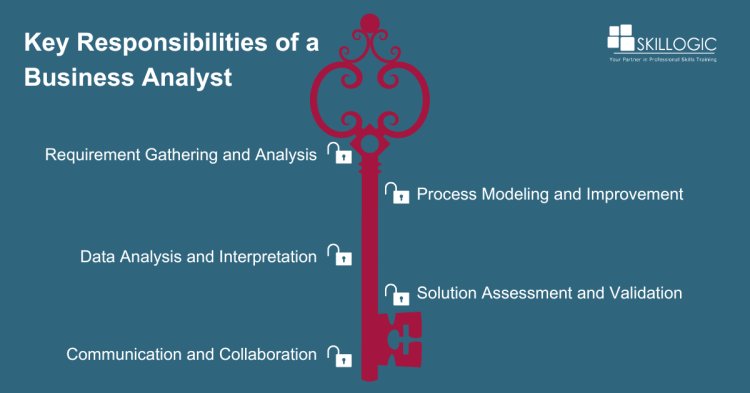
Skills Required for Business Analysts:
Business Analysts play a pivotal role in driving organizational success, requiring a diverse skill set to excel in their roles. According to data from Indeed, Business Analysts in the United States enjoy an average annual salary of $84,502, showcasing the competitive compensation in one of the globe's foremost economies. Similarly, in the United Kingdom, Indeed reports an average yearly salary of £44,727 for Business Analysts, reflecting the favorable remuneration in the European market. Additionally, Glassdoor reveals that, Business Analysts in India command a noteworthy average annual salary of ₹8,50,000, highlighting the increasing acknowledgment and worth of Business Analysis expertise in emerging economies. However, there are certain skills expected from business analysts;
Analytical Skills: The ability to interpret complex data, identify patterns, and derive meaningful insights to inform decision-making processes.
Communication Skills: Effective verbal and written communication skills are crucial for articulating ideas, requirements, and recommendations to diverse stakeholders.
Problem-Solving Skills: Business analysts must be adept at identifying problems, analyzing root causes, and developing innovative solutions to address organizational challenges.
Critical Thinking: The capacity to evaluate information objectively, assess implications, and make reasoned judgments in complex situations.
Technical Proficiency: Familiarity with relevant software tools, databases, and analytical techniques is essential for conducting data analysis and modeling.
Domain Knowledge: A solid understanding of the industry, business processes, and organizational dynamics is necessary to effectively translate business needs into actionable solutions.
Collaboration Skills: Business analysts must work closely with cross-functional teams, fostering collaboration, and consensus to achieve project objectives.
Attention to Detail: Meticulous attention to detail is essential for capturing requirements accurately, documenting processes, and ensuring quality assurance.
Adaptability: The ability to adapt to changing priorities, requirements, and project dynamics in a fast-paced environment is vital for success as a business analyst.
Time Management: Effective time management skills enable business analysts to prioritize tasks, meet deadlines, and manage multiple projects concurrently.
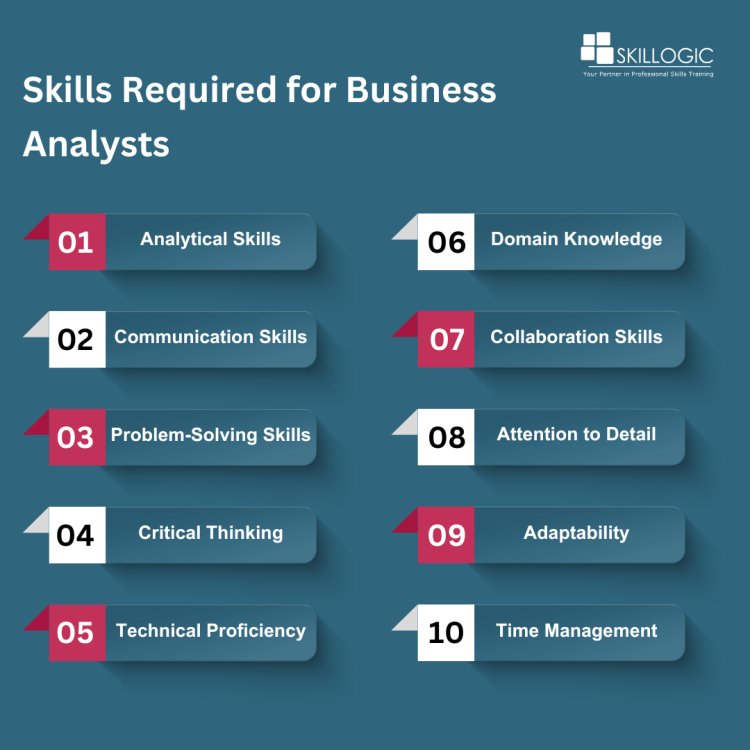
Tools and Techniques Used by Business Analysts
Data Analysis Tools: Software such as Microsoft Excel, Tableau, or Power BI for analyzing and visualizing data to derive insights and inform decision-making.
Business Process Modeling Tools: Tools like Microsoft Visio or Lucidchart for creating visual representations of business processes, workflows, and system architectures.
Requirement Management Tools: Platforms such as JIRA, Trello, or IBM Rational DOORS for capturing, organizing, and managing project requirements throughout the development lifecycle.
Prototyping Software: Tools like Axure RP or Balsamiq for creating interactive prototypes and mockups to visualize and validate user requirements and design concepts.
UML (Unified Modeling Language): A standardized visual modeling language used to represent system architectures, software designs, and business processes.
SWOT Analysis: A strategic planning technique used to evaluate an organization's strengths, weaknesses, opportunities, and threats to inform strategic decision-making.
Interviews and Workshops: Techniques for gathering requirements and eliciting stakeholder input through structured interviews, focus groups, brainstorming sessions, and workshops.
Use Case Modeling: A technique for documenting functional requirements by defining interactions between users and a system to accomplish specific goals or tasks.
Gap Analysis: A method for assessing the variance between current and desired states, identifying areas for improvement or intervention within an organization.
Decision Trees and Decision Tables: Tools used to model decision logic and outcomes, aiding in the evaluation of alternative courses of action and their potential impacts.
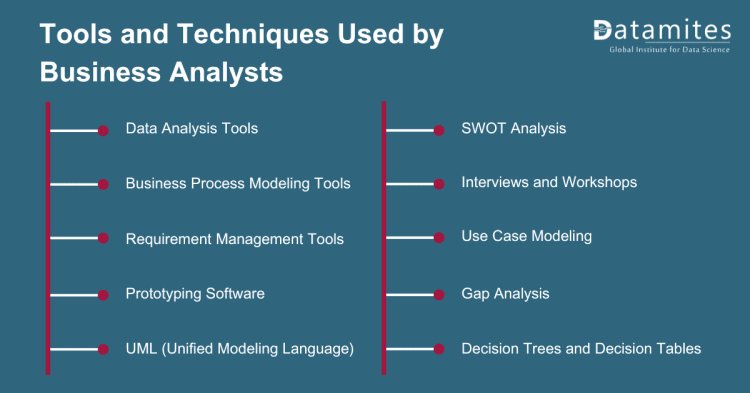
Refer:
- Business Analytics Course Fee in Bangalore
- Business Analytics Course Fee in Hyderabad
- Business Analytics Course Fee in Pune
Challenges Faced by Business Analysts
Ambiguous Requirements: Untangling unclear or contradictory requirements from stakeholders, which can hinder project progress and lead to misunderstandings.
Scope Creep: Managing changes in project scope throughout development, which can strain resources, timelines, and project objectives.
Communication Barriers: Overcoming communication obstacles between technical and non-technical stakeholders, impacting the clarity and effectiveness of project discussions and decisions.
Resource Constraints: Working within limited budgets, timeframes, or manpower, which may compromise the thoroughness and quality of analysis and solutions.
Lack of Domain Knowledge: Grappling with unfamiliar business domains or industries, which can impede the ability to accurately understand and address business needs.
Technology Constraints: Adapting to constraints imposed by existing technology infrastructure, which may limit the feasibility or effectiveness of proposed solutions.
Organizational Culture: Navigating organizational hierarchies, politics, and cultural dynamics that may hinder collaboration, decision-making, or change management efforts.
Data Quality Issues: Dealing with data inaccuracies, inconsistencies, or gaps, which can undermine the reliability and validity of analysis outcomes and decision-making processes.
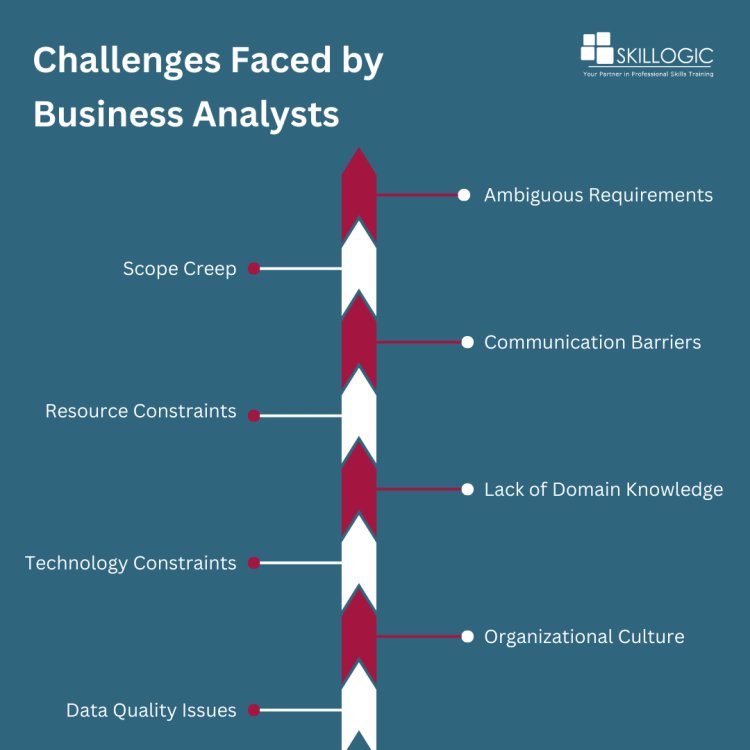
Business analysts play a pivotal role in driving organizational success by leveraging their key responsibilities and essential skills. They serve as interpreters of business needs, utilizing analytical prowess to uncover insights, facilitate effective communication, and champion transformative initiatives. The importance of their role lies in their ability to align business strategies with actionable insights, ensuring that decisions are informed, solutions are optimized, and value is maximized.
SKILLOGIC institute, a leading provider of professional training and certification courses, offers specialized Business Analytics Courses accredited by IABAC (International Association of Business Analytics Certifications). With a commitment to delivering high-quality education and empowering professionals with industry-relevant skills, SKILLOGIC's Business Analytics Training equip learners with the knowledge and expertise to excel in the dynamic field of business analysis.
SKILLOGIC Training Institute provides expert-led certification courses in Six Sigma, PMP, Cybersecurity, and Business Analytics. With more than a decade of experience, it offers practical, career-oriented training. SKILLOGIC operates offline centers in key Indian cities, making high-quality education easily accessible to help individuals enhance their skills and boost career growth.

0
312